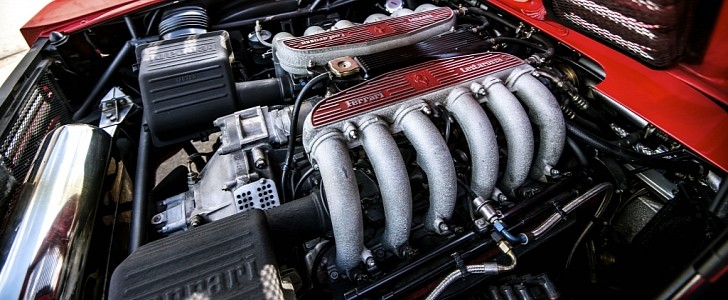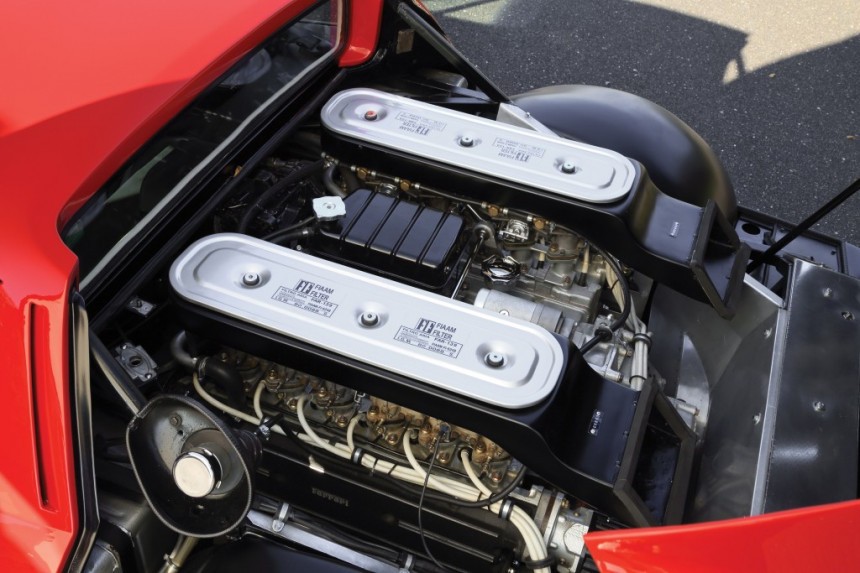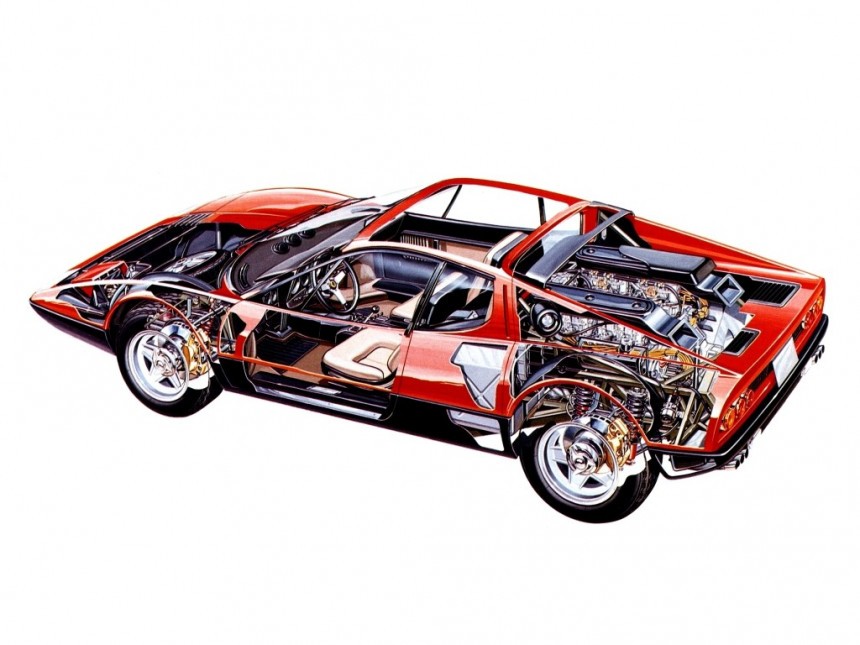The 815 may be the first car designed and assembled by Enzo, but it’s not a thoroughbred Prancing Horse. The Barchetta-styled 125 S that numbers only two units is considered the starting point of the Italian automaker, and it set the stage for most road-going flagship Fezzas to date with two particularities: 12 cylinders arranged in a V and natural aspiration.
Following the Colombo, Lampredi, and Jano engine families, the V12 configuration took a back step for a while in favor of the flat-12 architecture designed by Giuliano de Angelis and Angelo Bellei. Loosely inspired by the 180-degree unit developed by the legendary Mauro Forghieri, the powerplant we’ll cover today was introduced by the 365 GT4 BB in 1971.
Before going any further into the Prancing Horse’s flat-12 dynasty, it’s mandatory to clear out a few misconceptions. First of all, the BB acronym didn’t stand for Berlinetta Boxer when it was on the drawing board. Forghieri stated rather clearly that it’s Berlinetta Bialbero, the latter word standing for two camshafts. The MV Agusta 125 Bialbero also comes to mind, a racing motorcycle with a four-stroke DOHC single-cylinder engine.
Although the pistons are horizontally opposed, the powerplant is better described as a 180-degree V12 instead of a twelve-pot boxer. Derived from the 312B and 312PB racing cars that used Forghieri’s design, the block is complemented by a lot of componentry from the 60-degree Colombo V12.
The biggest difference between a V12 with the cylinder banks angled at 180 degrees and a 12-cylinder boxer comes in the guise of crankpins. Each set of opposing pistons shares a crankpin in the 365 GT4 BB while the boxer layout flexes individual crankpins to increase the linear offset between the banks.
Leonardo Fioravanti, the gentleman who designed the 512 BB and Testarossa, claims that BB stands for French actress Brigitte Bardot. That’s how Fioravanti and his buddies - Angelo Bellei and Sergio Scaglietti - called the 365 GT4 BB prototype because of its bite-the-back-of-your-hand beautiful lines. That said, BB can be considered a dual-purpose acronym depending on the context.
The Daytona-replacing sports car was developed specifically to rival the Lamborghini Miura, and 387 units were produced from 1973 through 1976. Mounted longitudinally rather than the transverse V12 of the Raging Bull, the 4.4-liter engine produced 375 horsepower on full song. The 365 GT4 BB was never sold in the United States, and the same can be said about its direct successors: the carbureted 512 BB and fuel-injected 512 BBi.
5 stands for the liters of displacement although it’s actually a 4.9-liter motor (4,943 cubic centimeters), and 12 designates the number of cylinders. Just like the 365 GT4 BB, the 512 siblings feature a five-speed manual transmission located below the crankshaft. Despite the compact packaging, this engineering decision pretty much defeats the purpose of a horizontally-opposed powerplant because it translates to a fairly high center of gravity.
Ferrari produced a total of 1,936 examples from 1976 to 1984, the year the flat-12 engine was updated for the Testarossa. The perfect car for the decade of greed, the Testarossa still is a superstar thanks to Miami Vice.
Don’t, however, mistake it for a supercar because it has lost comparisons against the Countach and more affordable nameplates that include the M5. It’s actually a grand tourer with a top speed of 290 kilometers per hour (180 miles per hour), and those strakes on the sides are there because of safety regulations. Since cashing in was the name of the game in the 1980s, you could say that Ferrari came up with the perfect vehicle at the perfect time.
Instead of Jetronic fuel injection from Bosch, the dry-sump engine received the German company’s Motronic system for the 512 TR. Changes were also made to the inlet plenums and valves for a more efficient fuel/air mix, raising the output from 380 horsepower to 422 horsepower. The 512 TR also corrected the awful clutch of the Testarossa with a single-plate system and sliding ball-style bearings. Ferrari had also improved the steering, braking, and suspension, which is why the 512 TR is the better driver’s car.
Featured on the cover of the very first Need for Speed video game, the wide-bodied model was replaced by the F512 M in 1994 when NFS was released on the 3DO home video game console. Only 501 units of the Modificata were made through 1996 when the front-engined 550 replaced it.
Ever since, flagship Ferraris have relied on free-breathing V12s.
Before going any further into the Prancing Horse’s flat-12 dynasty, it’s mandatory to clear out a few misconceptions. First of all, the BB acronym didn’t stand for Berlinetta Boxer when it was on the drawing board. Forghieri stated rather clearly that it’s Berlinetta Bialbero, the latter word standing for two camshafts. The MV Agusta 125 Bialbero also comes to mind, a racing motorcycle with a four-stroke DOHC single-cylinder engine.
Although the pistons are horizontally opposed, the powerplant is better described as a 180-degree V12 instead of a twelve-pot boxer. Derived from the 312B and 312PB racing cars that used Forghieri’s design, the block is complemented by a lot of componentry from the 60-degree Colombo V12.
The biggest difference between a V12 with the cylinder banks angled at 180 degrees and a 12-cylinder boxer comes in the guise of crankpins. Each set of opposing pistons shares a crankpin in the 365 GT4 BB while the boxer layout flexes individual crankpins to increase the linear offset between the banks.
The Daytona-replacing sports car was developed specifically to rival the Lamborghini Miura, and 387 units were produced from 1973 through 1976. Mounted longitudinally rather than the transverse V12 of the Raging Bull, the 4.4-liter engine produced 375 horsepower on full song. The 365 GT4 BB was never sold in the United States, and the same can be said about its direct successors: the carbureted 512 BB and fuel-injected 512 BBi.
5 stands for the liters of displacement although it’s actually a 4.9-liter motor (4,943 cubic centimeters), and 12 designates the number of cylinders. Just like the 365 GT4 BB, the 512 siblings feature a five-speed manual transmission located below the crankshaft. Despite the compact packaging, this engineering decision pretty much defeats the purpose of a horizontally-opposed powerplant because it translates to a fairly high center of gravity.
Ferrari produced a total of 1,936 examples from 1976 to 1984, the year the flat-12 engine was updated for the Testarossa. The perfect car for the decade of greed, the Testarossa still is a superstar thanks to Miami Vice.
Instead of Jetronic fuel injection from Bosch, the dry-sump engine received the German company’s Motronic system for the 512 TR. Changes were also made to the inlet plenums and valves for a more efficient fuel/air mix, raising the output from 380 horsepower to 422 horsepower. The 512 TR also corrected the awful clutch of the Testarossa with a single-plate system and sliding ball-style bearings. Ferrari had also improved the steering, braking, and suspension, which is why the 512 TR is the better driver’s car.
Featured on the cover of the very first Need for Speed video game, the wide-bodied model was replaced by the F512 M in 1994 when NFS was released on the 3DO home video game console. Only 501 units of the Modificata were made through 1996 when the front-engined 550 replaced it.
Ever since, flagship Ferraris have relied on free-breathing V12s.























